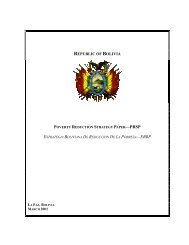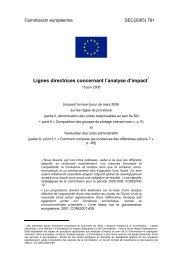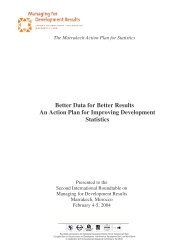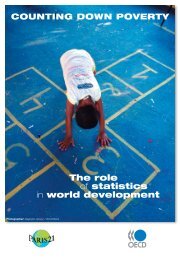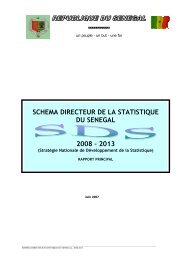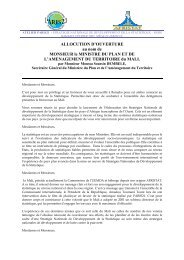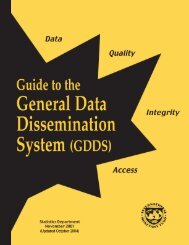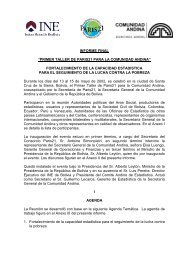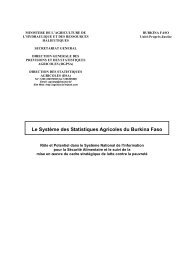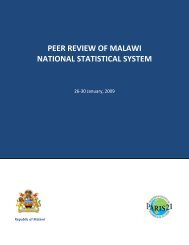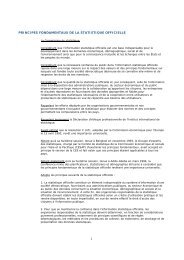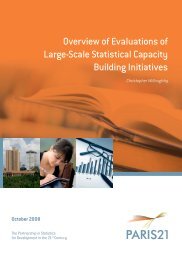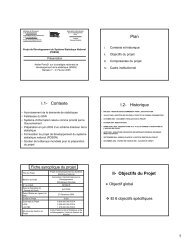MALAYSIA: Strategic Plan Department of Statistics 2010-14 - Paris21
MALAYSIA: Strategic Plan Department of Statistics 2010-14 - Paris21
MALAYSIA: Strategic Plan Department of Statistics 2010-14 - Paris21
Create successful ePaper yourself
Turn your PDF publications into a flip-book with our unique Google optimized e-Paper software.
MESSAGECHIEF STATISTICIAN, <strong>MALAYSIA</strong>Assalamualaikum warahmatullahi wabarakatuh and salam sejahtera.First and foremost, I would like to express my gratitude to Allah S.W.T with His permissionand blessings, the <strong>Strategic</strong> <strong>Plan</strong> <strong>of</strong> the <strong>Department</strong> <strong>of</strong> <strong>Statistics</strong>, Malaysia <strong>2010</strong>-20<strong>14</strong>has been successfully formulated.The <strong>Strategic</strong> <strong>Plan</strong> <strong>of</strong> the <strong>Department</strong> <strong>of</strong> <strong>Statistics</strong>, Malaysia <strong>2010</strong>-20<strong>14</strong> is anenhancement <strong>of</strong> the previous Corporate <strong>Plan</strong>s, with a shift towards upgrading the<strong>Department</strong>’s role as the leading statistical agency for national planning and development.This <strong>Strategic</strong> <strong>Plan</strong> is in line with the government’s aspiration to inculcate a culture <strong>of</strong> highperformance in the public service.This <strong>Strategic</strong> <strong>Plan</strong> sets the direction <strong>of</strong> the <strong>Department</strong> for the next five years. The <strong>Plan</strong>was formulated to address the needs <strong>of</strong> the statistical community. The changes in theexternal environment and its implications to the <strong>Department</strong> have also been taken intoconsideration in the preparation <strong>of</strong> this <strong>Plan</strong> so that it remains as the premier statisticalagency.I strongly believe that this <strong>Strategic</strong> <strong>Plan</strong> will provide a comprehensive guideline indelivering excellent statistical services to the users, both the public and private sector.Finally, I would like to congratulate and thank all parties for their contribution in preparingthe <strong>Strategic</strong> <strong>Plan</strong> <strong>of</strong> the <strong>Department</strong> <strong>of</strong> <strong>Statistics</strong> Malaysia <strong>2010</strong>-20<strong>14</strong>.‘PRODUCER OF NATIONAL STATISTICS’DATO’ HAJAH WAN RAMLAH WAN ABD.RAOFSTRATEGIC PLAN <strong>2010</strong>– 20<strong>14</strong>DEPARTMENT OF STATISTICS, <strong>MALAYSIA</strong>v
INTRODUCTION1.1 Background <strong>of</strong> the <strong>Department</strong> <strong>of</strong> <strong>Statistics</strong>, MalaysiaEstablishment <strong>of</strong>DOSMThe <strong>Department</strong> <strong>of</strong> <strong>Statistics</strong>, Malaysia (DOSM) was establishedin 1949 under the <strong>Statistics</strong> Ordinance 1949 and was then knownas Bureau <strong>of</strong> <strong>Statistics</strong>. The <strong>Statistics</strong> Ordinance 1949 wasreplaced by the <strong>Statistics</strong> Act 1965. Under this Act, the Bureau <strong>of</strong><strong>Statistics</strong> was known as the <strong>Department</strong> <strong>of</strong> <strong>Statistics</strong>, headed bythe Chief Statistician. The <strong>Statistics</strong> Act 1965 was revised in1989. The functions <strong>of</strong> the <strong>Department</strong> are explicitly definedunder Section 2(2):“The functions <strong>of</strong> the <strong>Department</strong> shall be to collect and interpretstatistics for the purpose <strong>of</strong> furnishing information required in theformation or carrying out the Government policy in any field orotherwise required for Government purposes or for meeting theneeds <strong>of</strong> trade, commerce, industry or agriculture (includingforestry, fishing and hunting)”.In 1965, DOSM comprised 12 divisions at the Headquarters,Kuala Lumpur and two branch <strong>of</strong>fices in Sabah and Sarawak. Thetotal staff then was 363 persons, <strong>of</strong> which 313 were at theHeadquarters, 20 in Sabah and 30 in Sarawak. In tandem with thecountry’s economic development and increasing demand forstatistical information, a series <strong>of</strong> restructuring exercises wereundertaken with the latest in 2007. With this restructuring, DOSMwas organised into three programmes namely Management/Coordination Services Programme (MCSP), Social/DemographicProgramme (SDP) and Economic Programme (EP) consisting19 divisions at the Headquarters, <strong>14</strong> State Offices and 28Operational Centres. Currently, DOSM has a staff strength <strong>of</strong>3,3<strong>14</strong>.In general, the function <strong>of</strong> MCSP is to provide support services tothe Divisions and State Offices with regards to human resourcemanagement, finance, information technology, user services andmatters related to the implementation <strong>of</strong> censuses/surveys. TheSDP and EP are responsible for preparing and analysing social/demographic and economic statistics while the State Offices andOperational Centres are responsible for data collection,processing and data quality control. The organisational structure<strong>of</strong> <strong>Department</strong> <strong>of</strong> <strong>Statistics</strong>, Malaysia is shown in Chart 1.STRATEGIC PLAN <strong>2010</strong> - 20<strong>14</strong>DEPARTMENT OF STATISTICS, <strong>MALAYSIA</strong>3
INTRODUCTIONChart 1: Organisational Structure<strong>Department</strong> <strong>of</strong> <strong>Statistics</strong>, Malaysia4STRATEGIC PLAN <strong>2010</strong> - 20<strong>14</strong>DEPARTMENT OF STATISTICS, <strong>MALAYSIA</strong>
INTRODUCTION1.2 Statistical System <strong>of</strong> MalaysiaStatistical System<strong>of</strong> MalaysiaMalaysia adopts a centralised statistical system. DOSM isresponsible in generating <strong>of</strong>ficial statistics <strong>of</strong> the country throughcensuses/surveys and compilations <strong>of</strong> secondary data.Nevertheless, other ministries/departments/government agenciessuch as Bank Negara Malaysia, Ministry <strong>of</strong> Agriculture andAgro-based Industry as well as Ministry <strong>of</strong> Human Resourcesmay produce statistics according to their requirements.Principal <strong>Statistics</strong>The principal statistics produced by DOSM comprise economic areassuch as agriculture, mining and quarrying, manufacturing,construction, services, national accounts, balance <strong>of</strong> payments,economic indicators and external trade. Meanwhile, social/demographic statistics covers population, labour force, householdincome and expenditure, prices, environment, health, education andhousing.The coordination <strong>of</strong> data collection among agencies is essential toensure comparability <strong>of</strong> data collected. This is implemented through:a. Inter Agency Technical Committee;b. Technical consultancy to ministries/agencies in the field <strong>of</strong>statistics; andc. Cadre <strong>of</strong>ficers as technical ambassadors in the ministries/agencies.1.3 Governance <strong>of</strong> Statistical SystemTo assist DOSM in identifying the needs <strong>of</strong> users, two committeeswere established in 1988 to determine guidelines, policies andpriorities for statistical activities:a. <strong>Statistics</strong> Steering Committee; andb. Main User Committee.Through this mechanism, the <strong>Department</strong> is able to fulfil the nation’sneeds in generating data <strong>of</strong> high quality and integrity as well asattaining international standards.STRATEGIC PLAN <strong>2010</strong> - 20<strong>14</strong>DEPARTMENT OF STATISTICS, <strong>MALAYSIA</strong>5
INTRODUCTIONIn 1988, the <strong>Statistics</strong> SteeringCommittee and Main User Committeewere formed to determineguidelines, policies and priorities forstatistical activities.Chairperson:Members:MAIN USER COMMITTEEDirector General,Economic <strong>Plan</strong>ning UnitChief Statistician, Malaysiaand representatives from:Ministry <strong>of</strong> FinanceSTATISTICS STEERING COMMITTEEChairperson: Chief Secretary to theGovernmentMembers: Director General<strong>of</strong> Public ServicesSecretary General<strong>of</strong> TreasuryDirector General,Economic <strong>Plan</strong>ning UnitGovernor,Bank Negara MalaysiaChief Statistician, MalaysiaSecretariat : Economic <strong>Plan</strong>ning UnitSecretariat :Terms <strong>of</strong> Reference :Bank Negara MalaysiaMinistry <strong>of</strong> International Tradeand IndustryMalaysia AdministrativeModernisation andManagement <strong>Plan</strong>ning Unit<strong>Department</strong> <strong>of</strong> <strong>Statistics</strong>,Malaysiaa. Identify and define statistical priorities andrequirements in line with the current planningneeds, in order to enable the <strong>Department</strong> <strong>of</strong><strong>Statistics</strong> to operate efficiently and seamlessly;b. Coordinate, at the technical level, the collectionTerms <strong>of</strong> Reference :a. Determine guidelines and policy for the<strong>Department</strong> <strong>of</strong> <strong>Statistics</strong>, Malaysia int h e i m p l e m e n t a t i o n o f i t sresponsibilities;b. Coordinate activities related to thecollection and dissemination <strong>of</strong> statisticscarried out by government agencies;andc. Provide guidelines towards aneffective national information system.and dissemination <strong>of</strong> statistics by governmentagencies in order to ensure, among others:i. The efficient and effective utilisation <strong>of</strong>available resources;ii. The use <strong>of</strong> standard concepts, definitionsand classifications;iii. The use <strong>of</strong> appropriate and effectiveiv.methods in the collection and production <strong>of</strong>statistics;The minimisation <strong>of</strong> duplication; andv. The production <strong>of</strong> quality and timely data.c. Set up Technical Working Groups forspecific statistical activities.6STRATEGIC PLAN <strong>2010</strong> - 20<strong>14</strong>DEPARTMENT OF STATISTICS, <strong>MALAYSIA</strong>
INTRODUCTION1.4 Statistical Delivery SystemAn efficient and effective delivery system is essential indisseminating information and services to customers andusers. This system is continuously enhanced in line withthe development <strong>of</strong> the information and communicationtechnology through:generation <strong>of</strong> information that adhere to thecustomers and users requirements;coordination between data producers and users;formation <strong>of</strong> institutional and legal framework;adoption <strong>of</strong> international standards, methodology,concepts and definitions and classifications;enhancement <strong>of</strong> human capital; andprovision <strong>of</strong> the latest and appropriate informationand communication technology (ICT)infrastructure.1.5 Vision and Mission1.5.1 VisionVISIONTo Become aLeading StatisticalOrganisationInternationally by2020The vision and mission outlined by the <strong>Department</strong>are in accordance with its role as the Producer <strong>of</strong>National <strong>Statistics</strong>. It is envisaged towardsachieving statistical services <strong>of</strong> high standardscomparable with national statistical organisations <strong>of</strong>developed countries.The vision is based on:Malaysia as a developed nation in 2020. As such,comprehensive statistics are vital to monitor thegrowth <strong>of</strong> the country through the provision <strong>of</strong>economic and social indicators; andThe year 2020 is an appropriate time frame toensure the <strong>Department</strong> will be able to providecomprehensive statistics in the economic and socialsectors.STRATEGIC PLAN <strong>2010</strong> - 20<strong>14</strong>DEPARTMENT OF STATISTICS, <strong>MALAYSIA</strong>7
INTRODUCTION1.10 Stakeholders and Customers<strong>Statistics</strong> produced by DOSM are used for national planning and development.DOSM’s stakeholders are:i. Economic <strong>Plan</strong>ning Unit (EPU);ii. Ministry <strong>of</strong> Finance (MOF);iii. Bank Negara Malaysia (BNM);iv. Ministry <strong>of</strong> International Trade and Industry (MITI);v. Ministry <strong>of</strong> Domestic Trade, Co-operatives andConsumerism (MDTCC); andvi. Other Ministries.InternationalMain UsersEconomic<strong>Plan</strong>ning UnitMinistry <strong>of</strong>FinanceBNMMITIMDTCCOther ministriesExternalUNWorld BankASEANSecretariatWHOFAOIMFADBESCAPILOOICNSOsNGOsChamber <strong>of</strong>CommerceConsumerAssociationsTrade UnionsYouthAssociationsInternalOther CategoryMembers <strong>of</strong>ParliamentPublic CommissionsEmbassy/HighCommissionsPrivate sectorsStudents/ResearchersPublicOperation CentreDivisionsState Offices12STRATEGIC PLAN <strong>2010</strong> - 20<strong>14</strong>DEPARTMENT OF STATISTICS, <strong>MALAYSIA</strong>
ENVIRONMENT CHANGE AND ITS IMPLICATION TO DOSM2.1 Issues and ChallengesChallengesfacedThe DOSM is responsive to the various challenges as itaffects the structure and functions <strong>of</strong> the <strong>Department</strong>.Among the challenges faced by DOSM are issues relatedto National Development Policies and the NationalVision, globalisation, economic liberalisation, transition <strong>of</strong>the economy from production-based to knowledge-based,ICT development and telecommunications. Being theproducer <strong>of</strong> national statistics, it is imperative for DOSM toproduce and interpret relevant statistical information infulfilling the demand for decision making and policyformulation. The main challenges faced by DOSM are:2.1.1 National Development Policy andNational VisionTo ensure the implementation <strong>of</strong> DevelopmentPolicies and National Vision is on the right path, theGovernment continuously review and evaluate theeffectiveness <strong>of</strong> the development programmes. As aresult, there would be changes in prioritisation ordiscontinuation <strong>of</strong> programmes and the introduction <strong>of</strong>new policies.Concept“1Malaysia -People First,Performance Now ”The government is in the midst <strong>of</strong> formulating the TenthMalaysia <strong>Plan</strong> (MP) based on the outcome approachtowards realising Vision 2020 in line with the mainthrusts <strong>of</strong> National Mission and “1Malaysia - PeopleFirst, Performance Now” concept. To ensure effectiveplanning and implementation <strong>of</strong> the developmentprogrammes, the thrusts <strong>of</strong> National Mission areelaborated in the NKRA and the Key Results Area(KRA) in the Tenth MP.Hence, as the producer <strong>of</strong> national statistics, thedirection and strategies <strong>of</strong> DOSM should be flexible intandem with the National Mission and the NKRA.STRATEGIC PLAN <strong>2010</strong> - 20<strong>14</strong>DEPARTMENT OF STATISTICS, <strong>MALAYSIA</strong>17
ENVIRONMENT CHANGE AND ITS IMPLICATION TO DOSM2.1.2 GlobalisationThe rapid developments in ICT and economic liberalisationhave accelerated market globalisation. Changes in thedirection <strong>of</strong> globalisation have significantly affected the nation’scompetitiveness.The advancement <strong>of</strong> ICT and its increased use in trade hasallowed better accessibility to various products and servicesworldwide. ICT has also enabled trade transactions andinternational services to be conducted online. In the medicalfield, online clinical specialists’ consultancy services areavailable. For example, analysis <strong>of</strong> a scanned x-ray image froma hospital in Malaysia which requires a specialist opinion fromabroad would be transmitted online. The foreign specialistwould then send the report back to Malaysia. All thetransactions and payments are done online.Another example is international trade transactions. Purchasing<strong>of</strong> computer s<strong>of</strong>tware, films, videos and audios via internet arerapidly growing across national borders through onlinepayment. These two examples illustrate the enormouschallenges faced by DOSM in the collection <strong>of</strong> accurate andcomprehensive information.The progress in ICT has also affected globalisation process. Asa result, information are transmitted rapidly. An event orinformation available in real-time causes the information to beeasily obsolete. Users are able to compare DOSM’s productsand the release time with that <strong>of</strong> other national statisticalorganisations. Thus, proactive measures and responsivenessto the current needs as well as setting new benchmarks in theproduction <strong>of</strong> <strong>of</strong>ficial national statistics are the priority <strong>of</strong> DOSM.The openness in the ICT system does not only facilitate abetter delivery <strong>of</strong> products however, it poses threats to thesecurity <strong>of</strong> information. Online data transmission fromproviders to DOSM or vice versa is always exposed to intrusionby cyber criminals. Furthermore, systems application and data18STRATEGIC PLAN <strong>2010</strong> - 20<strong>14</strong>DEPARTMENT OF STATISTICS, <strong>MALAYSIA</strong>
ENVIRONMENT CHANGE AND ITS IMPLICATION TO DOSMrepository are also susceptible to hackers. This is achallenge to DOSM to provide a secured cyber security.In the borderless world and increasing demand for data,timeliness and data reliability are crucial. In 1996,IMF introduced a data standard known as SDDS whichfocuses on timeliness and transparency in the production<strong>of</strong> data. To fulfil the standard, DOSM will expand thecoverage <strong>of</strong> Advanced Release Calendar to other areas<strong>of</strong> subject matter.Globalisation has also given opportunities to companiesin Malaysia to expand its investment abroad. Theseactivities have grown rapidly. As more companies areinvolved, the number <strong>of</strong> country destinations had alsoincreased. The expansion <strong>of</strong> these activities had posedchallenges to the balance <strong>of</strong> payments statistics incollecting data for direct investment abroad.2.1.3 Economic LiberalisationThe services sector is an important component in thenation’s economy, contributing about 55 per cent to theGDP in 2008 <strong>of</strong> which 47.6 per cent wasnon-government services. This sector also accounted for57 per cent <strong>of</strong> the total employment in Malaysia.Realising the potential growth in the services sector, thegovernment has decided to liberalise the 27 servicessubsectors, with no equity condition imposed. Thesesubsectors cover health and social, tourism,transportation, business and computers services andother related services.Liberalisation <strong>of</strong> the services sector is beingimplemented with the aim <strong>of</strong> developing a conducivebusiness environment to attract investments,technologies, as well as to create high skilledemployment opportunities. These efforts are expected toSTRATEGIC PLAN <strong>2010</strong> - 20<strong>14</strong>DEPARTMENT OF STATISTICS, <strong>MALAYSIA</strong>19
ENVIRONMENT CHANGE AND ITS IMPLICATION TO DOSMincrease the services sector competitiveness and to act as anew economic growth sector. Thus, it will stimulate thesector’s contribution to the economic growth.The drastic change in Malaysian economy requirestransformation in the monitoring and implementation systems.This will not only have a direct impact on the structure <strong>of</strong> theeconomy but also on the data collection system. Newindustries continue to flourish rapidly across the nation’sboundary. Thus, necessitate a more comprehensive balance <strong>of</strong>payments statistics particularly in the International TradeServices Sector which enable stakeholders and users tomonitor the impact <strong>of</strong> liberalisation. The dependency on existingdata sources no longer able to fulfil the current and futureneeds.2.1.4 Demand <strong>of</strong> the General Public on the Usage andAccessibility <strong>of</strong> DataThe present society is highly knowledgeable and exposed to thevarious sources <strong>of</strong> global information. Economic analysis is nolonger at a macro level instead it has become more complexand detailed. As a result, the stakeholders’ and users’expectation have increased and varies.Sampling designThus, as more information is gathered, the more detailedanalysis is required. To overcome these challenges, an efficientsampling design and smaller sample size that produce robustestimates will be introduced. Besides, detailed estimationprocedures will be looked into in order to obtain preciseestimates at smaller level.The globalisation and advancement in ICT have enabled freeflow <strong>of</strong> information and becomes a challenge to DOSM asprovider <strong>of</strong> <strong>of</strong>ficial statistics. Users tend to compare the productsand dissemination methods practiced by DOSM with that <strong>of</strong>other national statistical agencies. This creates pressure toDOSM to provide a better dissemination infrastructure and20STRATEGIC PLAN <strong>2010</strong> - 20<strong>14</strong>DEPARTMENT OF STATISTICS, <strong>MALAYSIA</strong>
ENVIRONMENT CHANGE AND ITS IMPLICATION TO DOSMcomprehensive information via relevant medium <strong>of</strong>communication.2.1.5 D e m a n d o n E v i d e n c e - B a s e dDecision MakingIn the 1970’s and 1980’s, the monitoring and analysis<strong>of</strong> economy were generally at macro level. Status <strong>of</strong>development and economic forecast were aimed atnational level. In the 1990’s, the requirements <strong>of</strong> datacascaded to state level. The monitoring <strong>of</strong> economicprogress is now focused on regional and smallerareas.At present, decisions made during planning,implementation and monitoring <strong>of</strong> policies are mostlybased on evidence. These are done through thefeedback systems and in-depth studies pertaining toany issue. Evidences do not only prove the success orfailure <strong>of</strong> programme, status and progress <strong>of</strong>programme but also specific areas at micro level. Asan example, analysis on poverty does not onlydetermine the rate; the data must be able to showwhere the poor are located. Thus, DOSM has tomigrate from current practices towards the use <strong>of</strong>geospatial data.Stakeholders require in-depth analysis which canrelate the data to the actual situation. This entails ahigh analytical skills and knowledge. DOSM willcontinue to enhance the analytical ability <strong>of</strong> itspersonnel.STRATEGIC PLAN <strong>2010</strong> - 20<strong>14</strong>DEPARTMENT OF STATISTICS, <strong>MALAYSIA</strong>21
ENVIRONMENT CHANGE AND ITS IMPLICATION TO DOSM2.1.6 Coordination in Data CollectionIntegratedquestionnaireDOSM undertakes various surveys in economic and socialsectors. Data collection in the economic sectors needs tobe coordinated in order to reduce respondents’ burden. Atthe same time, there are several similar variables beingcollected in the different surveys from the sameestablishments. The evolution <strong>of</strong> data requirements ashighlighted earlier compelled the widening <strong>of</strong> areas <strong>of</strong>research. Hence, data collection has become morecomplex.The use <strong>of</strong> integrated questionnaires will lessenrespondent’s burden as well as operational costs. Inaddition, the use <strong>of</strong> administrative data will complementexisting data sources. Here, DOSM will leverage on theadvancement in ICT and networking among governmentagencies to optimise the usage <strong>of</strong> administrative data.2.2 SWOT analysisSWOT analysis was used to identify measures to enhanceachievements through opportunities and improve the currentweaknesses. This analysis was carried out to identify:strengths and weaknesses <strong>of</strong> DOSM activities based onin-depth analysis, with specific follow-up actions; and opportunities and threats that will assist in thedevelopment <strong>of</strong> the strategic plan.The use <strong>of</strong> resources, latest technology and collaboration withgovernment agencies are among the opportunities envisaged.22STRATEGIC PLAN <strong>2010</strong> - 20<strong>14</strong>DEPARTMENT OF STATISTICS, <strong>MALAYSIA</strong>
ENVIRONMENT CHANGE AND ITS IMPLICATION TO DOSMDOSM has identified the obstacles and threats that couldhinder its vision <strong>of</strong> becoming a leading statisticalorganisation. Figure 1 shows the strengths, weaknesses,opportunities and threats as follows:Figure 1: SWOT AnalysisSTRENGTHSWEAKNESSES1. Established organisation withcompetent personnel.2. Certified MS ISO 9001:2008.3. Established research methodologyand statistical compilation.4. Good sampling frame.5. <strong>Statistics</strong> advisors in specificareas.6. Consultants in statistics to otheragencies.7. Internationally recognisedpersonnel.8. Conducive working environment.9. Equipped with ICT infrastructureand <strong>of</strong>fice equipments.10. Adoption <strong>of</strong> best practices instatistics.11.Structured training programmes.1. Insufficient research and detailedstatistical analysis.2. Inadequate communication <strong>of</strong>statistics to the community.3. Insufficient use and study on thelatest statistical s<strong>of</strong>tware.4. Lack <strong>of</strong> study on users’requirements.5. Lack <strong>of</strong> collaboration withinstitutions <strong>of</strong> higher learning.6. Dissemination system is mostly inthe form <strong>of</strong> publications.OPPORTUNITIESTHREATS1. Exploring, examining andenhancing the field <strong>of</strong> statistics.2. Support from the government inthe form <strong>of</strong> finance, technology andtraining abroad.3. Use <strong>of</strong> administrative data fromOGAs.4. Continuous request for newproducts by stakeholders.1. Retirement <strong>of</strong> knowledgeable<strong>of</strong>ficers.2. Competition from othergovernment agencies.3. Legal factors (Acts that preventdata sharing).4. Over-abundance <strong>of</strong> ad-hoc datarequests.5. Customers’ confidence in thequality <strong>of</strong> data produced.6. Establish greater cooperation andcommunication withinternational organisations.STRATEGIC PLAN <strong>2010</strong> - 20<strong>14</strong>DEPARTMENT OF STATISTICS, <strong>MALAYSIA</strong>23
ENVIRONMENT CHANGE AND ITS IMPLICATION TO DOSM2.3 Implications to the <strong>Department</strong> <strong>of</strong> <strong>Statistics</strong>,MalaysiaThe effects <strong>of</strong> globalisation, changes in national economic andsocial agenda, developments in information technology, users’expectations on delivery system, pressure arising from adversereactions <strong>of</strong> respondents have serious implications to DOSM. Inadapting to the environment, DOSM needs to be moreresponsive and sensitive to the changes in consumers’behaviour and be innovative in providing services in a morechallenging environment. DOSM will:Strengthen its role as the leading agency producingstatistics which are user oriented to meet current andfuture needs through benchmarking the bestpractices <strong>of</strong> reputable statistical organisations.To focus on collaboration with other governmentagencies and the private sectors to increaseresearch, data sharing and to reduce respondents’burden.To review and enhance methodologies, proceduresand survey manuals so as to produce data in a timelymanner, reduce cost and increase response rates viaa more pr<strong>of</strong>essional rapport with data suppliers.To focus on the establishment <strong>of</strong> a comprehensivebusiness registry and depicted into geospatial data.24STRATEGIC PLAN <strong>2010</strong> - 20<strong>14</strong>DEPARTMENT OF STATISTICS, <strong>MALAYSIA</strong>
ENVIRONMENT CHANGE AND ITS IMPLICATION TO DOSMTo develop first-class human capital thatare innovative and knowledgeable throughtraining, networking and activeparticipation at the international arena.To ensure continuous improvement in dataquality and reduced collection time,processing and data dissemination.To enhance information delivery systemsthrough the availability <strong>of</strong> time series datathat can be accessed interactively.To produce new products that is relevantand meet user requirement and focus onthe interpretation and analysis <strong>of</strong>statistics. To provide a wider understanding <strong>of</strong>statistics to organisations and communitiesthrough informational programmes andstatistical education. To ensure that each plan and workprogramme run smoothly, orderly andefficiently even after the retirement or thetransfer <strong>of</strong> an <strong>of</strong>ficer.To develop expertise through knowledgeenrichment in the field <strong>of</strong> statisticalanalysis. To ensure the organisation is strongthrough skilled and competent personneland the use <strong>of</strong> ICT, at par to those <strong>of</strong>developed countries.STRATEGIC PLAN <strong>2010</strong> - 20<strong>14</strong>DEPARTMENT OF STATISTICS, <strong>MALAYSIA</strong>25
THE ROLE OF THE DEPARTMENTThe <strong>Strategic</strong> <strong>Plan</strong> <strong>2010</strong> - 20<strong>14</strong> <strong>of</strong> the <strong>Department</strong> sets the frameworkto become a leading statistical agency internationally. Five majorroles have been identified namely as producer <strong>of</strong> national statistics,coordinator <strong>of</strong> statistical activities, enhancing the datacommunication, broaden the smart networking and strengthening thestatistical pr<strong>of</strong>ession.3.1 Producer <strong>of</strong> National <strong>Statistics</strong>As stipulated in the <strong>Statistics</strong> Act, the <strong>Department</strong> is tasked toproduce <strong>of</strong>ficial national statistics. Since its inception in 1949, the<strong>Department</strong> has produced quality data, user-oriented and timelystatistics for the formulation <strong>of</strong> national development policies andadministration.Globalisation, changes in the economic structure, sophisticatedand complex requests from users and ICT development have ledto new data requests and high expectations for statisticalservices. An analysis <strong>of</strong> external and internal environment <strong>of</strong> the<strong>Department</strong> indicates the needs to continuously evaluate servicedelivery system. In order to meet dynamic needs in a challengingenvironment, the <strong>Department</strong> is always responsive to users’requirements.Improvements in the statistical system and procedures willaccelerate delivery system <strong>of</strong> DOSM. This improvementencompasses continuous study on products, timeliness and dataquality. The <strong>Department</strong> will continue its efforts to developappropriate instruments and produce indicators which will assiststakeholders to formulate policies and monitor the plannedprogrammes. In addition, DOSM will produce seasonally adjusteddata and provide projections as well as estimations on maineconomic indicators to assist stakeholders in formulatingappropriate policies and programmes. Data usability will beSTRATEGIC PLAN <strong>2010</strong> - 20<strong>14</strong>DEPARTMENT OF STATISTICS, <strong>MALAYSIA</strong>29
THE ROLE OF THE DEPARTMENTdiversified and data analysis will be improved. These effortsare in line with dynamic economic scenario and globalisationwhich have implications on the needs for information.The business frames are continuously updated to ensure it iscomplete, efficient and current. Sampling methods arereviewed and improved through the application <strong>of</strong> bestsampling techniques. The usage <strong>of</strong> administrative data will beexpanded to complement the existing primary data andoptimise the use <strong>of</strong> resources and reduce respondents’ burden.Methods <strong>of</strong> data collection have been diversified from face t<strong>of</strong>ace interviews and mail to the use <strong>of</strong> appropriate tools andapplications in line with technological changes. Among thetools and applications used are Personal Digital Assistant(PDA), Computer Aided Telephone Interview (CATI) ande-survey.In realising the <strong>Department</strong>’s ICT <strong>Strategic</strong> <strong>Plan</strong>, an integratedsystem <strong>of</strong> preparation and data collection, processing anddissemination known as the National Enterprise-WideStatistical Systems (NEWSS) framework is currently underdevelopment. The first phase <strong>of</strong> NEWSS covers Labour ForceSurvey, Monthly Manufacturing Survey and Economic Surveys/Censuses. This system will be further expanded to includeother surveys as well as statistical compilation based onsecondary data. Full implementation <strong>of</strong> NEWSS will enhancethe capacity <strong>of</strong> the <strong>Department</strong> as the Producer <strong>of</strong> National<strong>Statistics</strong>.3.2 Coordinator <strong>of</strong> Statistical ActivitiesApart from being the <strong>of</strong>ficial producer <strong>of</strong> national statistics, the<strong>Department</strong> broaden its role as the coordinator for statisticalactivities in the country. Currently, the <strong>Department</strong> provides30STRATEGIC PLAN <strong>2010</strong>– 20<strong>14</strong>DEPARTMENT OF STATISTICS, <strong>MALAYSIA</strong>
THE ROLE OF THE DEPARTMENTtechnical consultancy which includes sampling andquestionnaire design; and data collection based on selectedrequests from users. In order to increase and coordinate thequality <strong>of</strong> researches in the country, the <strong>Department</strong> will extendtechnical consultancy to other agencies, organisations andresearchers. This will ensure high quality statistics areproduced.Coordination <strong>of</strong> statistical activities also covers the activities <strong>of</strong>harmonisation <strong>of</strong> codes, classifications and definitions used byall agencies through the establishment <strong>of</strong> Inter AgencyTechnical Committee (IATC) under the PERKASA STATSproject. This will improve the cooperation and enhance goodrelationship with other government agencies as well as t<strong>of</strong>acilitate access and the use <strong>of</strong> secondary data.DOSM receives feedback on data requirements fromstakeholders through the Main User Committee. Thegovernance <strong>of</strong> this committee will be strengthened andimproved to balance the needs <strong>of</strong> stakeholders and the capacity<strong>of</strong> the <strong>Department</strong>.3.3 Enhancement <strong>of</strong> Data CommunicationThe <strong>Department</strong> has strengthened its capacity in datacommunication, for instance, monthly data can be accessed viaportal. However, most <strong>of</strong> the statistics currently are published inhardcopy and compact discs (CD). Nonetheless, the formatsand contents <strong>of</strong> publications will continuously be improved tosuit users’ needs.The advancement in ICT and increasing statistical literacyamong users have resulted in sophisticated and complex datarequirements. Thus, data communication will be givenemphasis.STRATEGIC PLAN <strong>2010</strong> - 20<strong>14</strong>DEPARTMENT OF STATISTICS, <strong>MALAYSIA</strong>31
THE ROLE OF THE DEPARTMENTPortal is the best medium to improve data communication.Aggregated and time series data together with user manualare provided in the portal. Free downloads <strong>of</strong> data andpublications will enhance data accessibility.Interactive databases through online data sharing increasesdata communication and allow users to do data mining.Database on Small and Medium Enterprise (SME) andAgriculture Database are available whilst EnvironmentDatabase is currently under development. At the same time,under NEWSS project, databases for Labour Force Survey,Monthly Manufacturing Survey and Economic Surveys/Censuses are in the developmental stages. To enhance datacommunication and accessibility, databases will be extendedto other data collected by the <strong>Department</strong>.Besides the data communication to stakeholders, the<strong>Department</strong> will extend its data delivery to specific targetgroups such as students or institutions <strong>of</strong> higher learning andresearchers. As practised by other statistical agencies, the<strong>Department</strong> will create a webpage which is accessible to allusers. This approach will increase data accessibility andimprove statistical literacy among users.To further strengthen data communication, the <strong>Department</strong>utilises facilities provided by e-government through shortmessaging system (SMS) known as mySMS. Seven mainindicators namely Population, GDP, consumer price index,external trade, monthly manufacturing, industrial productionindex and unemployment rate are available in mySMS. Thisfacility will be expanded to other indicators.In line with the country’s development, more detailed data arerequired at the lowest level <strong>of</strong> analysis. For this purpose,32STRATEGIC PLAN <strong>2010</strong>– 20<strong>14</strong>DEPARTMENT OF STATISTICS, <strong>MALAYSIA</strong>
THE ROLE OF THE DEPARTMENTDOSM will outline policies and relevant data collectionmethods in order to provide micro data to thestakeholders and other users.3.4 Smart NetworkingSmart networking has intensified research, methodologydevelopment, knowledge sharing and life-long learning.The synergy from this networking would improve thequality <strong>of</strong> data produced.Smart networking would be strengthened with higherlearning institutions, Ministry <strong>of</strong> Education, Ministry <strong>of</strong>Higher Learning and other related agencies to createportal on statistics for educational purposes andparticipating in career exhibitions and talks.Organising and participating in international statisticalactivities are increasingly significant. The <strong>Department</strong> willcontinue to organise and participate in related activitiessuch as International Comparison Programme, foreigndirect investment, industrial statistics, input-output tablesand capital stock. Among the international institutionsrelated to these activities are the United Nations <strong>Statistics</strong>Division (UNSD), World Bank, Institute <strong>of</strong> DevelopingEconomies (IDE), Australian Bureau <strong>of</strong> <strong>Statistics</strong> (ABS)and IMF. The current smart networking will be broadenedthrough training opportunities with other national statisticalagencies and pr<strong>of</strong>essional statistical bodies.Collaboration in data sharing with related governmentagencies will be enhanced. This collaboration has beenformalised through Memorandum <strong>of</strong> Understandings withBank Negara Malaysia, Companies Commission <strong>of</strong>Malaysia, Employees’ Provident Fund and TourismSTRATEGIC PLAN <strong>2010</strong> - 20<strong>14</strong>DEPARTMENT OF STATISTICS, <strong>MALAYSIA</strong>33
THE ROLE OF THE DEPARTMENTMalaysia. It will be further extended to the Ministry <strong>of</strong>Health, Ministry <strong>of</strong> Education, Malaysian Communicationsand Multimedia Commission and others.Smart networking will be further enhanced through periodicdialogue sessions with data providers and the privatesectors. These will facilitate data collection process whicheventually fulfil users’ requirements.3.5 Strengthening Statistical Pr<strong>of</strong>essionThe <strong>Department</strong> is responsible in nurturingpr<strong>of</strong>essional statisticians who will be recognised both locallyand internationally. To support this effort, continuoustraining is undertaken by establishing comprehensivetraining roadmap. Personnel are equipped with adequatetraining to develop excellent and versatile individuals.Improvement in training opportunities for cadre <strong>of</strong>ficers willensure their services as technical ambassadorscontinuously relevant.These pr<strong>of</strong>essionals are able to provide technicalconsultancy services to local and international agencies.A directory <strong>of</strong> experts will be created to facilitatereferences.To promote pr<strong>of</strong>essionalism, personnel are encouraged toconduct research and analysis. They are also encouragedto document their findings in statistical journals. Being astatistical practitioner, recognition <strong>of</strong> the statistics pr<strong>of</strong>essionis <strong>of</strong> paramount importance, to be at par with internationalstandard. Thus, the vision <strong>of</strong> the <strong>Department</strong> to become aninternationally recognised statistical organisation will bematerialised.34STRATEGIC PLAN <strong>2010</strong>– 20<strong>14</strong>DEPARTMENT OF STATISTICS, <strong>MALAYSIA</strong>
STRATEGIC DIRECTION <strong>2010</strong>-20<strong>14</strong>4.1 IntroductionIn realising its vision and mission, DOSM hasoutlined the way forward that encompasses thestrategic thrusts, key areas and goals for theperiod <strong>2010</strong>-20<strong>14</strong> in tandem with its role as theProducer <strong>of</strong> National <strong>Statistics</strong>. This direction isformulated based on an analysis <strong>of</strong> the currentenvironment, issues and challenges such aseconomic liberalisation and globalisation, highexpectation <strong>of</strong> the stakeholders, lessenrespondents’ burden as well as the dynamicadvancement in ICT.The strategic direction also incorporates the focus <strong>of</strong> thecountry’s agenda, that is TO STRENGTHEN THEINSTITUTIONAL AND IMPLEMENTATIONCAPACITY as outlined in the National Mission Thrust2006-2020. The <strong>Department</strong> <strong>Strategic</strong> <strong>Plan</strong> (DSP) is alsoaligned to the NKRA and KRA as identified in the 10 thMP.4.2 Analysis <strong>of</strong> Four Action FrameworkIn formulating the <strong>Strategic</strong> Thrusts, DOSM hasidentified the activities that need to be raised,reduced, created and eliminated through the analysis <strong>of</strong>the Four Action Framework based on the Blue OceanStrategy.Enhancements in technical aspects particularly in subjectmatter expertise and development <strong>of</strong> new economic andsocial indicators enable the use <strong>of</strong> statistical knowledgeto fulfil the needs and expectations <strong>of</strong> policy makers,businesses and international communities. Technology,STRATEGIC PLAN <strong>2010</strong>– 20<strong>14</strong>DEPARTMENT OF STATISTICS, <strong>MALAYSIA</strong>37
STRATEGIC DIRECTION <strong>2010</strong>-20<strong>14</strong>resource management, communication and publicityaspects are also emphasised. In line with technologicaladvancement and the target in delighting the customers,the coordination <strong>of</strong> data requests through online system,is planned in accordance with the concept <strong>of</strong> people firstwhereby data users and service delivery are givenpriority. To strengthen the statistical services, datacollection will be improved further by reducingdependence on primary data. Irrelevant processes suchas in-silo data processing will be replaced by integratedprocessing through the implementation <strong>of</strong> NEWSS.The analysis <strong>of</strong> four action framework serves as inputs indeveloping the DSP so as to be more dynamic andefficient in the delivery system to meet the futurechallenges.4.3 <strong>Strategic</strong> ThrustDOSM strategic thrusts for the period <strong>2010</strong>-20<strong>14</strong> areformulated to strengthen the capabilities <strong>of</strong> the statisticalservices. The strategic thrusts provide an equal emphasison core businesses, human resources, financial as wellas information technology. Hence, three strategic thrustsare introduced:<strong>Strategic</strong> Thrust 1 To Produce Information <strong>of</strong> Integrityand Reliability<strong>Strategic</strong> Thrust 2 To Strengthen Research and Analysisas well as to Inculcate InnovationCulture<strong>Strategic</strong> Thrust 3 To Strengthen Resource Management38STRATEGIC PLAN <strong>2010</strong>– 20<strong>14</strong>DEPARTMENT OF STATISTICS, <strong>MALAYSIA</strong>
STRATEGIC DIRECTION <strong>2010</strong>-20<strong>14</strong><strong>Strategic</strong> Thrust 1:and reliabilityTo produce information <strong>of</strong> integrityDOSM is the main agency in providing statistics for policyformulation and implementation as well as for monitoringnational programmes. Hence, the information provided istimely, relevant, accurate and reliable. These fulfil the needsand expectations <strong>of</strong> the stakeholders and to strengthen theconfidence <strong>of</strong> users. The reliability <strong>of</strong> the information isascertained in terms <strong>of</strong> data source and coverage,methodology, processing and related analysis.In providing and sharing <strong>of</strong> information globally, DOSMadopts the UNSD (1994), Fundamental Principles <strong>of</strong> Official<strong>Statistics</strong>. Internalisation <strong>of</strong> the concepts and adoption <strong>of</strong> thecore values <strong>of</strong> the <strong>Department</strong> will place DOSM at par withadvanced statistical organisations. In this context,consultation with; and participation by stakeholders,ministries, other government agencies and private sectorsare adopted.Four strategies are outlined under <strong>Strategic</strong> Thrust 1:Strategy 1:To Strengthen the StatisticalServices in the Challenging andDynamic EnvironmentPresently, most <strong>of</strong> the stakeholders’and users’ needs have been fulfilled.However, the request for informationwill increase tremendouslyespecially with the pressure forevidence-based decision making.Hence, one <strong>of</strong> the initiatives taken isto strengthen the Malaysia’s Statistical System. Itintegrates all data collected by DOSM and other agenciesin the data repository.STRATEGIC PLAN <strong>2010</strong>– 20<strong>14</strong>DEPARTMENT OF STATISTICS, <strong>MALAYSIA</strong>39
STRATEGIC DIRECTION <strong>2010</strong>-20<strong>14</strong>This Strategy is implemented through:First Programme: To increase the ability in data collectionwhich includes various data collection methods and thissubsequently improve the effectiveness and optimal use <strong>of</strong>resources. Integrating the questionnaires, emphasising onthe most required variables and extending the use <strong>of</strong>administrative data from other agencies are among theefforts to be implemented. These approaches reduce therespondents’ burden so as to ensure high response rate, aswell as timely and quality information.Second Programme: To promote the use <strong>of</strong> concepts,codes and statistical classifications such as MalaysiaStandard Industrial Classification (MSIC) and MalaysiaClassification <strong>of</strong> Products by Activity (MCPA) to otherrelated government agencies. The effort supports theuniformity <strong>of</strong> information from other administrative datasources in accordance to national and internationalstatistical standards.Third Programme:To develop a central repository fordata collected and processed by DOSM and othergovernment agencies. This infrastructure is in line with thedynamic and challenging data usage by the usercommunity. Improving and providing various means inaccessing the information are being carried out concurrentlywith the enhancement <strong>of</strong> the database capacity as well assharing <strong>of</strong> micro data and small area statistics.Fourth Programme: To upgrade the capability in providingvarious data to support the policy makers in formulatingsocial and economic programmes. A wider scope <strong>of</strong> dataand new domestic and international economic data as wellas social statistics are the focus towards thestrengthening <strong>of</strong> statistical services. DOSM is committed toimprove the presentation <strong>of</strong> data, broaden the40STRATEGIC PLAN <strong>2010</strong>– 20<strong>14</strong>DEPARTMENT OF STATISTICS, <strong>MALAYSIA</strong>
STRATEGIC DIRECTION <strong>2010</strong>-20<strong>14</strong>statistical analysis as well as to provide detailed datadissemination according to current needs.Fifth Programme: To strengthen the Malaysia’sStatistical System through the coordination <strong>of</strong> datacollection activities between DOSM and other agencies.The implementation plan will enrich the data repositorycontent through the use <strong>of</strong> administrative data whichadhere to the concepts, definitions, codes andclassifications set at international level.Sixth Programme: To strengthen the household andestablishment frames through the enhancement <strong>of</strong> theCentral Registry System and the Census FrameDatabase System. The Central Registry System will becontinuously updated based on the latest companyregistration and through field work while the GlobalPositioning System (GPS) is used to enhance theidentification <strong>of</strong> the Enumeration Block boundaries.Strategy 2 :To Optimise the Use <strong>of</strong>Statistical Methodology andTechnologyOptimisation <strong>of</strong> statisticalmethodology and technologyapplications will reduce thedependency on human resourcesand therefore, enables more timelyoutput. This strategy is fulfiled by theintegration <strong>of</strong> technicalknowledge, s<strong>of</strong>t skills, s<strong>of</strong>tware andhardware and to adapt the best practices <strong>of</strong> theInternational Statistical Agencies. The programmesoutlined are as follows:First Programme: To strengthen data analysis byenhancing data acquisition and the application <strong>of</strong> bestanalytical techniques in specific areas. This is supportedwith continuous effort in the application <strong>of</strong> samplingtechniques and the use <strong>of</strong> advanced statistical s<strong>of</strong>tware.STRATEGIC PLAN <strong>2010</strong>– 20<strong>14</strong>DEPARTMENT OF STATISTICS, <strong>MALAYSIA</strong>41
STRATEGIC DIRECTION <strong>2010</strong>-20<strong>14</strong>Second Programme: To enhance the sampling designby reviewing the relevant sampling approach for theeconomic and household surveys. The use <strong>of</strong> appropriates<strong>of</strong>tware in generating statistics will be reviewedregularly. Continuous monitoring <strong>of</strong> the field operationsensure that the survey procedures are observed.Third Programme: To upgrade and extend the use <strong>of</strong>statistical methodology for estimates in the preparation <strong>of</strong>preliminary data or short term projection. Efforts are alsoundertaken to enhance the existing modelling techniquesto upgrade the ability in producing statistics within a shortperiod.Fourth Programme:To broaden the implementationscope <strong>of</strong> the NEWSS project in order to enhance theefficiency in data management and information. Thisencompasses the process <strong>of</strong> data collection, processingand dissemination <strong>of</strong> data. The advancement <strong>of</strong>technology and the strengthening <strong>of</strong> human resource willsupport the application <strong>of</strong> international standard and bestpractices.Strategy 3:To Increase the Understandingand Use <strong>of</strong> <strong>Statistics</strong> Among theUsers and Communitiesprogrammes outlined are:The <strong>Department</strong> emphasises on themarketing and promotion strategies<strong>of</strong> its products to the potential usersin line with the concept <strong>of</strong> statistics aspublic goods. In the scenario <strong>of</strong>evidence-based decision making,statistics should be easily accessibleto main users and the public.TheFirst Programme: To intensify publicity and promotionprogrammes through the enhancement <strong>of</strong> datadissemination and communication methods. It can beachieved by the utilisation <strong>of</strong> web portals, onlinedatabases and strategic partnerships with other agencies.42STRATEGIC PLAN <strong>2010</strong>– 20<strong>14</strong>DEPARTMENT OF STATISTICS, <strong>MALAYSIA</strong>
STRATEGIC DIRECTION <strong>2010</strong>-20<strong>14</strong>Apart from this, the involvement <strong>of</strong> media in datadissemination should be intensified. DOSM activelyparticipates in seminars, workshops and exhibitions onstatistics.Second Programme: To improve the data accessibilityby users are noted through the availability <strong>of</strong> onlinedatabases, developing interactive modules anddissemination via mySMS. Free downloads and onlinepayments are provided in the DOSM’s portal.Strategy 4 :To Expand Networking with DataProviders and UsersTo improve data collection, DOSMcontinuously expand the networking viaeffective coordination and collaborationwith data providers and users.Consultations with data users willimprove data communications.Consultation and statistical coordinationactivities will be intensified in the effort to position thestatistical services into the mainstream.The identified programmes are:First Programme: To enhance collaboration with dataprovider via data sharing agreement. Emphasis tostrengthen the functions <strong>of</strong> DOSM from the legal aspect isundertaken by reviewing the <strong>Statistics</strong> Act 1965(Revised - 1989).Second Programme: To increase consultation with datausers through existing mechanism such as <strong>Statistics</strong>Steering Committee and Main User Committee. Thesecommittees and the Inter Agency <strong>Plan</strong>ning Group (IAPG)are the platforms used to identify data requirements ornew social and economic indicators. Continuousinteractive sessions are organised to identify thestakeholders’ and users’ needs.STRATEGIC PLAN <strong>2010</strong>– 20<strong>14</strong>DEPARTMENT OF STATISTICS, <strong>MALAYSIA</strong>43
STRATEGIC DIRECTION <strong>2010</strong>-20<strong>14</strong><strong>Strategic</strong> Thrust 2: To strengthen research and analysisas well as to inculcate innovation cultureAs the national producer <strong>of</strong> statistics, DOSM will continue toreinforce its roles by strengthening the research andanalytical activities and inculcate the innovationculture among its workforce. Capability in applyingknowledge is the key to success <strong>of</strong> <strong>Strategic</strong> Thrust 2.Three strategies have been outlined under this strategicthrust.Strategy 1 :To Enhance Research andAnalysis CapabilityIn order to implement Strategy 1,programmes are planned to strengthencapabilities in research and data analysis.These programmes include:First Programme: To intensify dataanalysis. The objective <strong>of</strong> this programme is to enhance thevalue added <strong>of</strong> the products <strong>of</strong> the <strong>Department</strong> and toimprove the competency <strong>of</strong> the <strong>of</strong>ficers. Divisions/State<strong>of</strong>fices are required to produce two statistical researchpapers annually as well as to provide analysis for thepublished data.Second Programme: To conduct research in niche areas.This is to fulfil the new requirements <strong>of</strong> the stakeholders.Each Division is required to identify at least one newstatistical area for the period <strong>of</strong> <strong>2010</strong>-20<strong>14</strong>.44STRATEGIC PLAN <strong>2010</strong>– 20<strong>14</strong>DEPARTMENT OF STATISTICS, <strong>MALAYSIA</strong>
STRATEGIC DIRECTION <strong>2010</strong>-20<strong>14</strong>Strategy 2:To Nurture Innovation Culturein Producing and DeliveringStatistical Products and ServicesTo foster an innovation culture,knowledge enhancement throughcontinuous learning and training; andsmart networking with nationalstatistical <strong>of</strong>fices <strong>of</strong> advanced countries,higher learning institutions, domesticand foreign pr<strong>of</strong>essional bodies will be undertaken. Theprogrammes outlined include:First Programme: To continuously establish networkingwith main users, higher learning institutions; andpr<strong>of</strong>essional bodies, domestic and abroad. The objective<strong>of</strong> this programme is to promote knowledge sharing anddevelop expertise as well as to venture into newareas in statistics. The <strong>of</strong>ficers are always given theopportunities to attend seminars and meetings withinand outside the country. This initiative will encourageexchange <strong>of</strong> ideas among agencies particularly statisticalagencies.Second Programme: To continue the Innovative andCreative Group (ICG) activities. The focus <strong>of</strong> ICG is inthe core business areas, administration/finance and ICT.It is compulsory for the Divisions and State Offices toparticipate in ICG competition held annually.Third Programme: To participate in Star RatingProgramme at the ministry level to enhance the delivery<strong>of</strong> products and services.STRATEGIC PLAN <strong>2010</strong>– 20<strong>14</strong>DEPARTMENT OF STATISTICS, <strong>MALAYSIA</strong>45
STRATEGIC DIRECTION <strong>2010</strong>-20<strong>14</strong>Strategy 3 :To Develop Competent HumanCapital <strong>of</strong> High Level Pr<strong>of</strong>essionalismThe development <strong>of</strong>competent, creative andinnovative human capital withpositive attitude andspiritual values arecontinuously being inculcated.The Human CapitalDevelopment programmes are as follows:First Programme: To continue the strategic human capitaldevelopment through the strengthening <strong>of</strong> mind, body andsoul (MINJARO). It is implemented through internalisation andpractice <strong>of</strong> DOSM’s core values, promoting knowledgeenhancement and developing leadership skills. Training andcourses in the Competency <strong>Plan</strong> which coversfunctional,generic, behavioural, ICT, presentation <strong>of</strong> papers locally andinternationally constitute some <strong>of</strong> the activities that aremonitored and given importance.Second Programme: To continuously provide and enhancetechnical consultancy in various fields to local and foreignagencies. DOSM will continuously provide its <strong>of</strong>ficers courseson training <strong>of</strong> trainers/facilitators, organise intellectualdiscourse and premier talk by renowned persons regularly.Third Programme: To preserve knowledge throughKnowledge Management System with the objective toinculcate and encourage knowledge sharing. In the efforts todevelop competent and competitive human capital, theStatistical Training Institute Malaysia (ILSM) is established toexpand the current scope <strong>of</strong> Statistical Training Division. ILSMwill provide continuous and structured training programmes toenhance expertise and pr<strong>of</strong>essionalism in line with DOSM’saspiration to be at par with advanced countries.Fourth Programme: To develop a high performingorganisation and inculcate first class mentality throughperformance management based on KPI. The measurement<strong>of</strong> KPI at <strong>Department</strong>, Divisions and State Offices level will befurther cascaded to individuals to sustain and improveperformance.46STRATEGIC PLAN <strong>2010</strong>– 20<strong>14</strong>DEPARTMENT OF STATISTICS, <strong>MALAYSIA</strong>
STRATEGIC DIRECTION <strong>2010</strong>-20<strong>14</strong><strong>Strategic</strong> Thrust 3: To strengthen resourcemanagementStrategy 1 :To Strengthen Human ResourceManagementEfficient and effective resource management is animportant aspect that is continuously given priority. Theresource management strategy is realised through therecruitment <strong>of</strong> personnel, succession plan for strategicpositions, human resource database system, trainings,organisational development, placement <strong>of</strong> cadre <strong>of</strong>ficers,performance evaluation and recognition, financial andassets; and general administration.Seven programmes have beenoutlined to improve the DOSMHuman Resource Management:First Programme: To implement theplan to recruit new personnel based onthe studies and analysis with regards tostaff requirement at Divisional and State Offices level.The study will be based on current workloads, additionalresponsibilities and new challenges faced by DOSM.Second Programme:To implement succession planfor strategic positions for grade 48 and above. Selectionwill be based on characteristics <strong>of</strong> personnel withoutstanding personality, high performing, knowledgeableand skilful. DOSM needs to prepare future leaders tosucceed the leadership <strong>of</strong> the <strong>Department</strong>.Third Programme: To ensure that the HumanResource Management Information System (HRMIS) isfully utilised. The modules such as leave management,assets declaration etc. will be implemented to ensurecomplete records <strong>of</strong> staff electronically.Fourth Programme: To strengthen the TrainingManagement System (SPL) and development <strong>of</strong>personnel, systematically and continuously by taking intoSTRATEGIC PLAN <strong>2010</strong>– 20<strong>14</strong>DEPARTMENT OF STATISTICS, <strong>MALAYSIA</strong>47
STRATEGIC DIRECTION <strong>2010</strong>-20<strong>14</strong>account the Competency <strong>Plan</strong> and the financialcapability <strong>of</strong> the <strong>Department</strong>.Fifth Programme: To plan the review <strong>of</strong> the organisationstructure in line with the present needs. This is to ensurethat the <strong>Department</strong> is responsive to the users’ expectationsin a dynamic and challenging environment. Thus, it isimportant to review the existing human resource strengthand the organisational structure.Sixth Programme: To strengthen the placement <strong>of</strong> cadresin other government agencies and ministries as the mainreference person in statistical services.Seventh Programme: To improve the individual appraisaland recognition system. The <strong>Department</strong> will engage acomprehensive individual assessment through thesuperior-peer-subordinate evaluation approach based onindividual performance. Nevertheless, non-monetary rewardis also practiced in the <strong>Department</strong> where high performanceindividuals are rewarded accordingly.Five programmes have beenStrategy 2 :To Strengthen the Management <strong>of</strong>Finance and Assetsplanned to improve andstrengthen the management <strong>of</strong>finance and assets. These are:First Programme: To improvethe effectiveness <strong>of</strong> DOSM’s Management <strong>of</strong> BudgetPreparation. This important programme is formulated toensure the required budget is secured.Second Programme: To enhance and reinforce theAdministrative and Development Expenditure Managementby monitoring the financial allocations that are disbursedaccording to the programmes and schedules. Training on48STRATEGIC PLAN <strong>2010</strong>– 20<strong>14</strong>DEPARTMENT OF STATISTICS, <strong>MALAYSIA</strong>
STRATEGIC DIRECTION <strong>2010</strong>-20<strong>14</strong>financial management and other related trainings will beprovided to the staff in Financial Management to be moreequipped and capable in the Budget Management.Third Programme: To strengthen the procurementmanagement to obtain value for money in DOSM’sexpenditure.Fourth Programme: To ensure payment <strong>of</strong> bills throughthe e-SPKB/e-Perolehan comply to Treasury Circular No.7 <strong>of</strong> 2009, Treasury Amendment 103 <strong>of</strong> the bill paymentshould be paid within <strong>14</strong> days and avoid payment <strong>of</strong>Treasury bills under 58 (a) and the Treasury 59. To ensurethat bill reimbursement are made within <strong>14</strong> days withoutfail and disbursed in the current year, responsiblepersonnel must be competent to use this system. Training,courses and workshops on the use <strong>of</strong> the system will beheld from time to time.Fifth Programme: To streamline and strengthen themanagement and monitoring <strong>of</strong> Capital Assets and theGovernment mobile assets are systematic andeffectively implemented in accordance with proceduresand guidelines. Training, monitoring and compliance toenforce regulations, will be emphasised and considered toensure that the asset management is in order, completeand adequate.Strategy 3 :To Improve the Efficiency <strong>of</strong>Management and AdministrativeServicesFive programmes have been outlinedto improve the efficiency <strong>of</strong>Management and AdministrativeServices in DOSM.First Programme: To enhance thequality management to increase theawareness on the importance <strong>of</strong> quality. Through theseactivities, the Quality Management Meeting and projectsmonitoring will be carried out as scheduled. Moreover,continuous improvement will be implemented to achieve aSTRATEGIC PLAN <strong>2010</strong>– 20<strong>14</strong>DEPARTMENT OF STATISTICS, <strong>MALAYSIA</strong>49
STRATEGIC DIRECTION <strong>2010</strong>-20<strong>14</strong>significant level <strong>of</strong> quality to uplift the image <strong>of</strong> the<strong>Department</strong>. Studies will be undertaken to expand the scope<strong>of</strong> coverage to the MS ISO 9001:2008 and other recognisedquality standards.Second Programme: To establish an efficient secretariatand events management to ensure smooth and effectiveevents and meet the standards and quality as required.DOSM personnel will be provided with training, courses andhands-on to enrich their knowledge and skills in variousaspects.Third Programme: To strengthen the compliance toGovernment’s circulars, administrative instructions andregulations in force. The planned activities include efficient,systematic and uniform practices and adoptions <strong>of</strong> theadministrative procedures and guidelines, throughout the<strong>Department</strong>. Training and knowledge enhancement will beprovided to respective personnel so that best practices aresmoothly implemented.Fourth Programme: To ensure the safety andconduciveness <strong>of</strong> the DOSM’s work places are secured andcomply with Government procedures.Fifth Programme: To strengthen the Support ServiceManagement activities. Ensure quality planning and timelyreporting to the Management. Strengthen secretarial andcoordination skills by using effective managementtechnique. Coordinate the reporting activities <strong>of</strong> DOSM’sprogress reports and preparation <strong>of</strong> Government’sdocuments such as the Memorandum to the Cabinet andCabinet Information Note. Strengthen collaboration,communication and consultation with local and internationalagencies.50STRATEGIC PLAN <strong>2010</strong>– 20<strong>14</strong>DEPARTMENT OF STATISTICS, <strong>MALAYSIA</strong>
STRATEGIC DIRECTION <strong>2010</strong>-20<strong>14</strong>Strategy 4 :To Enhance the Resource andInformation Technology ManagementEfficiencyThe following programmeswere outlined to enhancethe use <strong>of</strong> IT as an enablerand the leader to achievethe tasks andobjectives <strong>of</strong> the<strong>Department</strong>.First Programme: To ascertain the hardware ands<strong>of</strong>tware are efficiently managed and maintained asoutlined in MS ISO 9001:2008.Second Programme: To ensure the hardwarereplacement plan is according to their life span and theincrease <strong>of</strong> personnel to enable smooth and effectivework flow; and increase the efficiency <strong>of</strong> ICT.Third Programme: To conduct trainings and coursesrelated to hardware and s<strong>of</strong>tware maintenance, securityand protection <strong>of</strong> information and s<strong>of</strong>tware procurementfor statistics and functional.Fourth Programme: To review the ICT <strong>Strategic</strong> <strong>Plan</strong>periodically to optimise and align with the needs <strong>of</strong> ICTand in line with the current functional requirement.Fifth Programme: To provide relevant ICT courses andtrainings for ICT personnel. This is implemented throughstructured training programmes according to the field <strong>of</strong>expertise and specialisation.STRATEGIC PLAN <strong>2010</strong>– 20<strong>14</strong>DEPARTMENT OF STATISTICS, <strong>MALAYSIA</strong>51
STRATEGIC DIRECTION <strong>2010</strong>-20<strong>14</strong>Relationship between the <strong>Strategic</strong> Thrusts and Strategies isdepicted in Figure 2.Figure 2: Relationship between <strong>Strategic</strong> Thrusts and Strategies<strong>Strategic</strong> Thrust1<strong>Strategic</strong> Thrust2<strong>Strategic</strong> Thrust3To produce information<strong>of</strong> integrity andreliabilityTo strengthen researchand analysis as well asto inculcate innovationcultureTo strengthen resourcemanagementStrategy 1 Strategy 1 Strategy 1To strengthen the statisticalservices in the challengingand dynamic environmentTo enhance research andanalysis capabilityTo strengthen humanresource managementStrategy 2 Strategy 2 Strategy 2To optimise the use <strong>of</strong> thestatistical methodology andtechnologyTo nurture innovation culturein producing and deliveringstatistical products andservicesTo strengthen themanagement <strong>of</strong> finance andassetsStrategy 3To increase theunderstanding and use <strong>of</strong>statistics among the usersand communitiesStrategy 3To develop competenthuman capital <strong>of</strong> high levelpr<strong>of</strong>essionalismStrategy 3To improve the efficiency <strong>of</strong>management andadministrative servicesStrategy 4 Strategy 4To expand networking withdata providers and usersTo enhance the resourceand information technologymanagement efficiency52STRATEGIC PLAN <strong>2010</strong>– 20<strong>14</strong>DEPARTMENT OF STATISTICS, <strong>MALAYSIA</strong>
STRATEGIC DIRECTION <strong>2010</strong>-20<strong>14</strong>4.4 Action <strong>Plan</strong>DOSM has outlined the Action <strong>Plan</strong> for the period <strong>of</strong><strong>2010</strong> - 20<strong>14</strong> to ensure the <strong>Strategic</strong> Thrusts areachieved.The Action <strong>Plan</strong> is supported by detailedImplementation <strong>Plan</strong>s.STRATEGIC PLAN <strong>2010</strong>– 20<strong>14</strong>DEPARTMENT OF STATISTICS, <strong>MALAYSIA</strong>53
IMPLEMENTATION MECHANISM5.1 INTRODUCTIONDSP <strong>2010</strong>-20<strong>14</strong> is used as a guide and to be implemented withfull commitment by DOSM’s personnel. For more effectiveimplementations to achieve the objectives, monitoring isessential. In this case, the progress <strong>of</strong> DSP implementation ismonitored through regular reporting at committees’ meetings.In the effort to ensure the smooth implementation <strong>of</strong> the DSP,a Steering Committee is established to monitor theimplementation plans. Steering Committee and ImplementationCommittee meetings will be held at least twice a year. Thestructures <strong>of</strong> the committees are as follows:Chart 2: Structure <strong>of</strong> the Steering Committee and ImplementationCommittee <strong>of</strong> the <strong>Department</strong> <strong>Strategic</strong> <strong>Plan</strong><strong>Strategic</strong> <strong>Plan</strong>Implementation Committee:Management/CoordinationServices Programme<strong>Strategic</strong> <strong>Plan</strong> SteeringCommittee<strong>Strategic</strong> <strong>Plan</strong>Implementation Committee:Social/DemographicProgramme<strong>Strategic</strong> <strong>Plan</strong>Implementation Committee:Economic ProgrammeSTRATEGIC PLAN <strong>2010</strong>– 20<strong>14</strong>DEPARTMENT OF STATISTICS, <strong>MALAYSIA</strong>57
IMPLEMENTATION MECHANISM5.2 <strong>Strategic</strong> <strong>Plan</strong> Steering CommitteeChairman :Members :Chief Statistician, MalaysiaDeputy Chief StatisticianSocial/Demographic ProgrammeDeputy Chief StatisticianEconomic ProgrammeSenior DirectorManagement and Human Resource DivisionSenior DirectorPrices, Income and Expenditure <strong>Statistics</strong> DivisionSenior DirectorNational Accounts <strong>Statistics</strong> DivisionSenior DirectorInformation Management DivisionDirectorData Coordination DivisionDirectorCorporate and User Services DivisionSecretariat :Corporate and User Services DivisionTerms <strong>of</strong> Reference:a) Provide guidance and advice in implementing the strategic plan.b) Assess the progress and achievement reports in line with thetarget set.c) Decide on the proposed changes <strong>of</strong> activities recommended bythe Implementation Committee.d) Make decisions on actions to be taken to ensure the smoothimplementation <strong>of</strong> the strategic plan.e) Decide on the improvements to overcome constraints inimplementing the strategic plan.58STRATEGIC PLAN <strong>2010</strong>– 20<strong>14</strong>DEPARTMENT OF STATISTICS, <strong>MALAYSIA</strong>
IMPLEMENTATION MECHANISM5.3 <strong>Strategic</strong> <strong>Plan</strong> Implementation Committee5.3.1 Management/Coordination ServicesProgrammeChairman :Director Data Coordination DivisionMembers :Senior DirectorManagement and Human Resource DivisionSenior DirectorInformation Management DivisionDirectorStatistical Training DivisionDirectorCorporate and User Services DivisionDirectorResearch and Development DivisionDirectorMethodology DivisionSecretariat :Research and Development DivisionSTRATEGIC PLAN <strong>2010</strong>– 20<strong>14</strong>DEPARTMENT OF STATISTICS, <strong>MALAYSIA</strong>59
IMPLEMENTATION MECHANISM5.3.2 Social/Demographic ProgrammeChairman :Deputy Chief Statistician Social/Demographic ProgrammeMembers :Senior DirectorPrices, Income and Expenditure <strong>Statistics</strong> DivisionDirectorPopulation and Housing Census <strong>Statistics</strong> DivisionDirectorDemographic <strong>Statistics</strong> DivisionDirectorManpower and Social <strong>Statistics</strong> DivisionDirectorAgriculture and Agro-Based <strong>Statistics</strong> DivisionDirectorEnvironment <strong>Statistics</strong> DivisionRepresentative <strong>of</strong> State OfficesSecretariat :Manpower and Social <strong>Statistics</strong> Division60STRATEGIC PLAN <strong>2010</strong>– 20<strong>14</strong>DEPARTMENT OF STATISTICS, <strong>MALAYSIA</strong>
IMPLEMENTATION MECHANISM5.3.3 Economic ProgrammeChairman :Deputy Chief Statistician Economic ProgrammeMembers :Senior DirectorNational Accounts <strong>Statistics</strong> DivisionSenior DirectorServices <strong>Statistics</strong> DivisionDirectorIndustrial Production and Construction <strong>Statistics</strong> DivisionDirectorExternal Trade <strong>Statistics</strong> DivisionDirectorEconomic Indicators DivisionDirectorBalance <strong>of</strong> Payments <strong>Statistics</strong> DivisionRepresentative <strong>of</strong> State OfficesSecretariat :Services <strong>Statistics</strong> DivisionSTRATEGIC PLAN <strong>2010</strong>– 20<strong>14</strong>DEPARTMENT OF STATISTICS, <strong>MALAYSIA</strong>61
IMPLEMENTATION MECHANISM5.4 Achievement TargetsThe details <strong>of</strong> the targets are shown in the Action and Implementation <strong>Plan</strong>s. Theexamples <strong>of</strong> such reports are as follows:5.4.1 <strong>Strategic</strong> Thrust 1<strong>Strategic</strong> Thrustand Strategy<strong>2010</strong> 2011 2012 2013 20<strong>14</strong>Strategy 1:To Strengthen theStatistical Services in theChallenging and DynamicEnvironment1 At least 3 monthly / quarterly surveys are conducted using e-survey2 Use <strong>of</strong> minimum five administrative data sources3Updating all establishments selected in economic survey and 60% <strong>of</strong>establishments which are not in the survey in the business frame<strong>Strategic</strong> Thrust 1:To Produce Information <strong>of</strong> Integrity and ReliabilityStrategy 2:To Optimise the Use <strong>of</strong>Statistical Methodology andTechnologyStrategy 3:To Increase theUnderstanding and Use<strong>of</strong> <strong>Statistics</strong> Among theUsers and Communities1 Minimum value <strong>of</strong> RSE for each variable studied23Six systems in the NEWSS areimplemented by end March <strong>2010</strong>and other systems implementedin stages between <strong>2010</strong> and2011Implementation<strong>of</strong> GIS map instrata 1, strata2 and strata 3by <strong>2010</strong>1 Increase publicity through electronic and print media at least 2 times a year2Interactive Module Development Using Business Intelligence (BI) for ExternalTrade Database3 Provide portal with free downloadsStrategy 4:To ExpandNetworking withData Providersand Users1 Collaboration with 10 identified data providers (OGAs)62STRATEGIC PLAN <strong>2010</strong>– 20<strong>14</strong>DEPARTMENT OF STATISTICS, <strong>MALAYSIA</strong>
IMPLEMENTATION MECHANISM5.4.2 <strong>Strategic</strong> Thrust 2<strong>Strategic</strong> Thrustand Strategy<strong>2010</strong> 2011 2012 2013 20<strong>14</strong>Strategy 1:To Enhance Research andAnalysis Capability1 Two papers (analysis)/ statistical journals by each Division / State Offices a year2 At least one new research produced for each division<strong>Strategic</strong> Thrust 2:To Strengthen Research and Analysis as well asto Inculcate Innovation CultureStrategy 2:To Nurture Innovation Culturein Producing and DeliveringStatistical Product andServicesStrategy 3:To Develop Competent Human Capital <strong>of</strong> HighLevel Pr<strong>of</strong>essionalism1 Collaboration with at least two other statistical agencies within <strong>2010</strong>-20<strong>14</strong>2 Participation in innovation and quality programmes12 Organise Executive Talk at least four times a yearStrengthening <strong>of</strong>Statistical TrainingInstitute Malaysia3 Full implementation <strong>of</strong> Knowledge Management System (KMS)1Implementation <strong>of</strong>PerformanceManagementSystem (PMS)STRATEGIC PLAN <strong>2010</strong>– 20<strong>14</strong>DEPARTMENT OF STATISTICS, <strong>MALAYSIA</strong>63
IMPLEMENTATION MECHANISM5.4.3 <strong>Strategic</strong> Thrust 3<strong>Strategic</strong> Thrustand Strategy<strong>2010</strong> 2011 2012 2013 20<strong>14</strong>1Candidates for pr<strong>of</strong>essional post have to sit for written examinations,assessment programmes and interviews prior to appointmentStrategy 1:To Strengthen HumanResource Management23Revieworganisationalstructure <strong>of</strong><strong>Department</strong>80% moduleandsubmodule <strong>of</strong>HRMIS isimplementedStrategy Thrust 3:To Strengthen Resources ManagementStrategy 2:To Strengthen theManagement <strong>of</strong> Financeand AssetsStrategy 3:To Improve theEfficiency <strong>of</strong> Management andAdministrative Services1 100% bills paid within <strong>14</strong> days1 Ensure all the programmes outlined by the Government are adheredStrategy 4:To Enhance the Resourceand Information TechnologyManagement Efficiency1 Application systems in placed based on users’ requirements2ISP to beprepared by<strong>2010</strong>64STRATEGIC PLAN <strong>2010</strong>– 20<strong>14</strong>DEPARTMENT OF STATISTICS, <strong>MALAYSIA</strong>
APPENDIX 1LAWS OF <strong>MALAYSIA</strong>ACT 415STATISTICS ACT 1965(Revised — 1989)STRATEGIC PLAN <strong>2010</strong>– 20<strong>14</strong>DEPARTMENT OF STATISTICS, <strong>MALAYSIA</strong>67
APPENDIX 1LAWS OF <strong>MALAYSIA</strong>ACT 415STATISTICS ACT 1965(Revised – 1989)____________ARRANGEMENT OF SECTIONS____________Section1. Short title and application.2. <strong>Department</strong> <strong>of</strong> <strong>Statistics</strong>.3. Control and management <strong>of</strong> the <strong>Department</strong>.4. Safeguards as to the use and communication <strong>of</strong> information.5. Notice to require particulars.6. Particulars not related to an undertaking.7. Penalty.8. Rules9. Repeal.68STRATEGIC PLAN <strong>2010</strong>– 20<strong>14</strong>DEPARTMENT OF STATISTICS, <strong>MALAYSIA</strong>
APPENDIX 1STRATEGIC PLAN <strong>2010</strong>– 20<strong>14</strong>DEPARTMENT OF STATISTICS, <strong>MALAYSIA</strong>69
APPENDIX 170STRATEGIC PLAN <strong>2010</strong>– 20<strong>14</strong>DEPARTMENT OF STATISTICS, <strong>MALAYSIA</strong>
APPENDIX 1STRATEGIC PLAN <strong>2010</strong>– 20<strong>14</strong>DEPARTMENT OF STATISTICS, <strong>MALAYSIA</strong>71
APPENDIX 172STRATEGIC PLAN <strong>2010</strong>– 20<strong>14</strong>DEPARTMENT OF STATISTICS, <strong>MALAYSIA</strong>
APPENDIX 2STRATEGIC PLAN <strong>2010</strong>– 20<strong>14</strong>DEPARTMENT OF STATISTICS, <strong>MALAYSIA</strong>73
APPENDIX 274STRATEGIC PLAN <strong>2010</strong>– 20<strong>14</strong>DEPARTMENT OF STATISTICS, <strong>MALAYSIA</strong>
APPENDIX 2STRATEGIC PLAN <strong>2010</strong>– 20<strong>14</strong>DEPARTMENT OF STATISTICS, <strong>MALAYSIA</strong>75
APPENDIX 276STRATEGIC PLAN <strong>2010</strong>– 20<strong>14</strong>DEPARTMENT OF STATISTICS, <strong>MALAYSIA</strong>
APPENDIX 2STRATEGIC PLAN <strong>2010</strong>– 20<strong>14</strong>DEPARTMENT OF STATISTICS, <strong>MALAYSIA</strong>77
APPENDIX 278STRATEGIC PLAN <strong>2010</strong>– 20<strong>14</strong>DEPARTMENT OF STATISTICS, <strong>MALAYSIA</strong>
APPENDIX 2STRATEGIC PLAN <strong>2010</strong>– 20<strong>14</strong>DEPARTMENT OF STATISTICS, <strong>MALAYSIA</strong>79
APPENDIX 280STRATEGIC PLAN <strong>2010</strong>– 20<strong>14</strong>DEPARTMENT OF STATISTICS, <strong>MALAYSIA</strong>
APPENDIX 2STRATEGIC PLAN <strong>2010</strong>– 20<strong>14</strong>DEPARTMENT OF STATISTICS, <strong>MALAYSIA</strong>81
APPENDIX 282STRATEGIC PLAN <strong>2010</strong>– 20<strong>14</strong>DEPARTMENT OF STATISTICS, <strong>MALAYSIA</strong>
APPENDIX 2STRATEGIC PLAN <strong>2010</strong>– 20<strong>14</strong>DEPARTMENT OF STATISTICS, <strong>MALAYSIA</strong>83
APPENDIX 284STRATEGIC PLAN <strong>2010</strong>– 20<strong>14</strong>DEPARTMENT OF STATISTICS, <strong>MALAYSIA</strong>
APPENDIX 2STRATEGIC PLAN <strong>2010</strong>– 20<strong>14</strong>DEPARTMENT OF STATISTICS, <strong>MALAYSIA</strong>85
APPRECIATIONDSP COMMITTEE <strong>2010</strong>-20<strong>14</strong>ADVISORYBhg. Dato’ Hajah Wan Ramlah Wan Abd. Ra<strong>of</strong>CHAIRMANYBrs. Dr. Haji Abdul Rahman HasanMEMBERSYBhg. Dato’ Nafsiah Haji Abu BakarMr. Kamarudin Muhamed (since September 2009)Ms. Omi Kelsom Haji EliasMs. Tay Suan SeeMs. Hajah Roszaini Omar (until March 2009)Mr. Haji Sabri Omar (March 2009 until November 2009)Dr. Mazlan Harun (since November 2009)Mr. Wan Mohammad Noor Wan MahmoodMr. Haji Azahari Mohd RaslanMs. Zubaidah IsmailMr. Haji Ibrahim JantanMs. Nazaria BaharudinMr. Kunnasegaran Gopalakrishnan (until April 2009)Ms. Norhayati JantanMs. Norfariza Hanim KasimMr. Mohd Yazid Kasim (since October 2009)Mr. Fazrul Azlan OthmanMs. Sa’adiah Ahmad (until October 2008)Ms. Siti Zakiah Muhamad IsaMs. Riyanti SaariMs. Siti Salwani IsmailMs. Nan Hasnani Long PadangMr. Ahmad Redzuan Abdul HadiMr. Mohamed Noor Aizam Saudin@Sudin86STRATEGIC PLAN <strong>2010</strong>– 20<strong>14</strong>DEPARTMENT OF STATISTICS, <strong>MALAYSIA</strong>
ACRONYMABSBNMCATICDAustralian Bureau <strong>of</strong> <strong>Statistics</strong>Bank Negara MalaysiaComputer Aided Telephone InterviewCompact DiscsMDTCCMINJAROMCPAMinistry <strong>of</strong> Domestic Trade,Co-operatives and ConsumerismMind, body and soulMalaysia Classification <strong>of</strong> Productsby ActivityDOSMDSPEPEPUGATSGFCF<strong>Department</strong> <strong>of</strong> <strong>Statistics</strong> Malaysia<strong>Department</strong> <strong>Strategic</strong> <strong>Plan</strong>Economic ProgrammeEconomic <strong>Plan</strong>ning UnitGeneral Agreement on Trade inServicesGross Fixed Capital FormationMCSPMPMOFMSICNEWSSManagement/CoordinationServices ProgrammeMalaysia <strong>Plan</strong>Ministry <strong>of</strong> FinanceMalaysia Standard IndustrialClassificationNational Enterprise-Wide StatisticalSystemGPSGlobal Positioning SystemNKRANational Key Results AreaHRMISIAPGIATCICGICRICTIDEILSMHuman Resource ManagementInformation SystemInter Agency <strong>Plan</strong>ning GroupInter Agency Technical CommitteeInnovative and Creative GroupIntelligent Character RecognitionInformation and CommunicationTechnologyInstitute <strong>of</strong> Developing EconomiesStatistical Training Institute MalaysiaOGAsPDASDPSDDSSMSSMESPLUNSDOther Government AgenciesPersonal Digital AssistantSocial/Demographic ProgrammeSpecial Data DisseminationStandardShort Messaging ServicesSmall and Medium EnterpriseTraining Management SystemUnited Nations <strong>Statistics</strong> DivisionIMFInternational Monetary FundKPIKey Performance IndicatorsKRAKey Results AreaMITIMinistry <strong>of</strong> International Trade andIndustrySTRATEGIC PLAN <strong>2010</strong>– 20<strong>14</strong>DEPARTMENT OF STATISTICS, <strong>MALAYSIA</strong>87
<strong>Department</strong> <strong>of</strong> <strong>Statistics</strong>, MalaysiaBlock C6, Complex CFederal Government Administrative Centre625<strong>14</strong> Putrajaya<strong>MALAYSIA</strong>Tel. : 603-8885 7000Fax : 603-8888 9248E-mail : jpbkkp@stats.gov.myWebsite : www.statistics.gov.my



